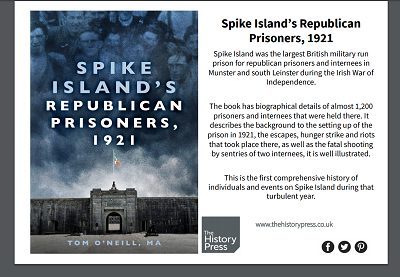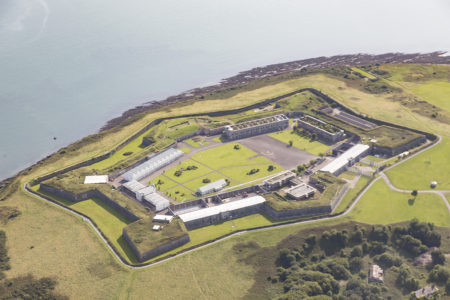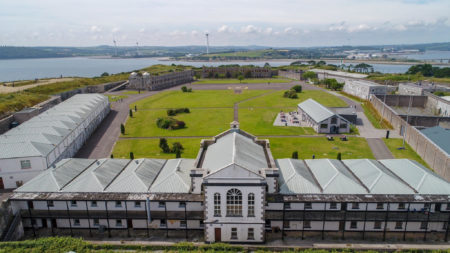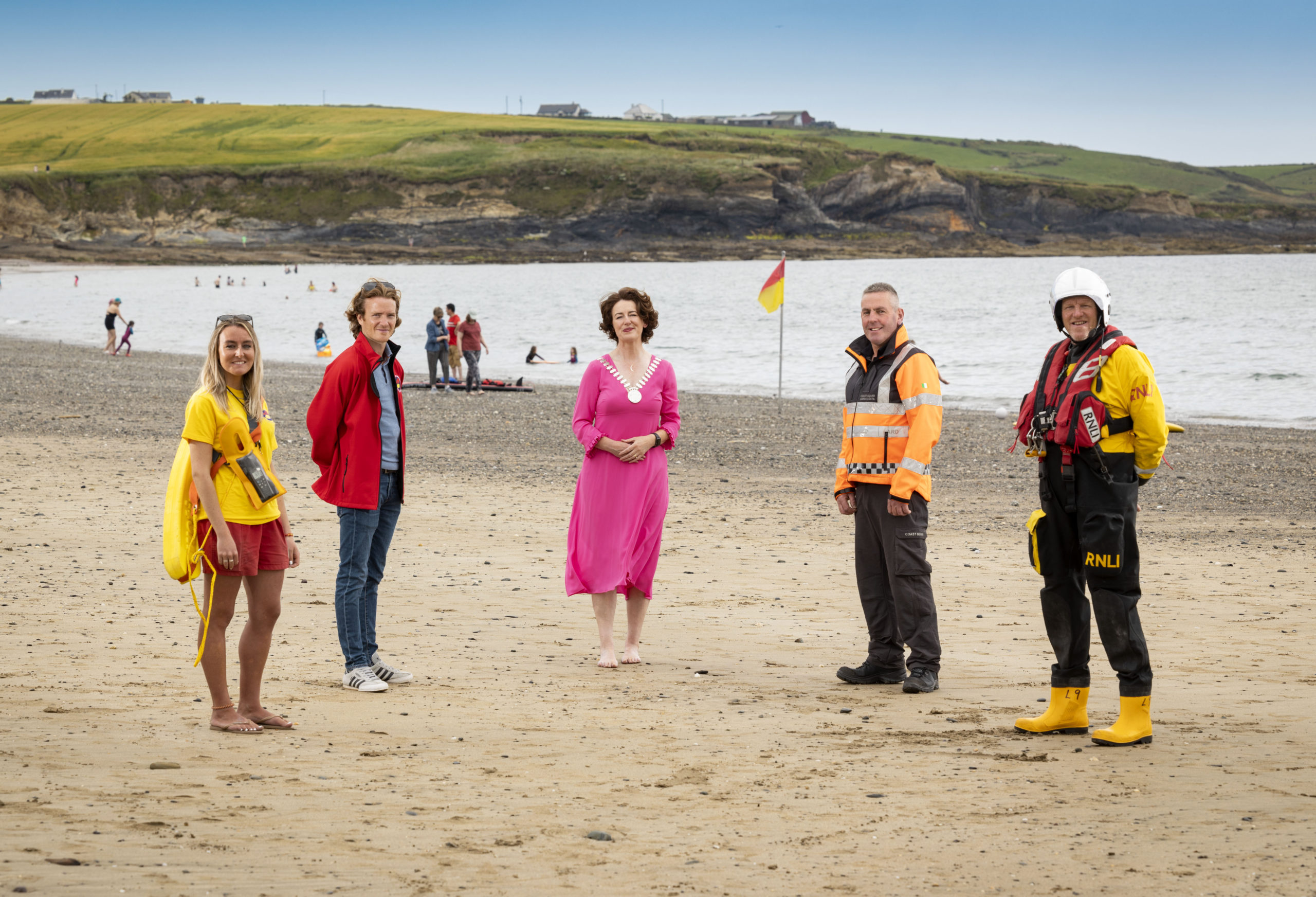25 July 2021
By Elaine Murphy
elaine@TheCork.ie
A new book has been published about the Irish War of Independence rebels held on Spike Island in 1921, which marks 100 years this year. Spike Island’s Republican Prisoners, 1921, is now on sale, authored by historian and long term island employee, Tom O’Neill. The book details the story of the island’s War of Independence prisoners, who were captured by the British authorities in Cork, Clare, Limerick, Waterford, Limerick and Tipperary, as well as Wexford and Kilkenny. A total of 1200 men were held across the 10 months the island prison was open, with up to 500 at any one time. It was the third time in its history that Spike island would be used to hold prisoners, following a mid-1600’s prisoner of war depot set up by Oliver Cromwell, and a famine-era convict depot that remained open from 1847 to 1883.
The author Mr O’Neill has compiled an extensive record of the prisoners and internees, using primary source material from Irish Military Archives, original British Army records from the UK National Archives and prisoners and internees’ autograph books. The book describes the setting up of the prison, the escapes, hunger strikes and riots that took part there, as well as the fatal shooting of internee Patrick White. It also contains details of the arrest, charge, trial, convictions, sentences and transfers of the prisoners. The book contains approximately 180 photographs and drawings. This is the first comprehensive history of individuals and events on Spike Island in 1921 to be published.
Author of the book, Tom O’Neill, has been researching the 1921 prison for over a decade. Mr O’Neill was appointed facilities manager with the Irish Prison Service on Spike Island in 1989, in the then island prison. He has been involved with the island ever since, now working in a research and operational role with the tourism site.
During the years that Spike Island was a civilian prison, the prison governor received regular requests from civilians to visit the island. Some requests came from British soldiers that had been based on the island. Requests were received from former residents and from members and former members of the Irish Defence Forces that had been based on Spike. Unfortunately, the only information available about that time were brief accounts of the two escapes and of the killing of Capt Patrick White while he was playing hurling. When Spike Island opened as a heritage centre in 2010, Mr O’Neill set himself the task of researching the era and if possible, publishing, an account of the events and individuals associated with Spike Island during 1921.
This book is the result of that research which took over a decade, and led to Dublin and London as the primary sources of information. Most of the primary source material for the book was found in the UK National Archives in Kew, London.
‘Spike Island’s Republican Prisoners 1921’ is a third solo book for Mr O’Neill, and he has co-written two other books. He has contributed articles to ‘Ireland’s Own’, ‘The Old Kerry Journal’, ‘The Irish Examiner’ and the Defence Forces magazine, ‘An Cosantoir.
He lives with his wife Ann, in Midleton, Co. Cork. The book is available for purchase in the island Gift Shop, where those interested can contact the island to have a copy sent out, and in shops and direct from the author.
Spike Island’s 1921 rebels
The rebels held on the island came from every town and village in Cork and most of the major towns in Munster. They had fought for Irish freedom against the impossible odds of defeating the British Empire, and their efforts forced a truce, and eventual Independence, on July 11th 1921. Despite the truce, the men continued to be held on Spike Island, with many not seeing freedom until after November 1921, when the prison closed.
Conditions in the prison were difficult, and during its opening period there were riots, hunger strikes, and even fatal prisoner shootings, with the killing of Clare man Patrick White. The book details what life was like for the prison inhabitants, and talks about some of the more famous inmates, like wanted man Richard Barrett, long term Wexford rebel John Sinnott, and the three Egan brothers, one of whom had been playing for Tipperary at Croke Park when ‘Bloody Sunday’ unfolded, and Michael Hogan was shot.
The book marks the culmination of a decade of research and it is released in tandem with an exhibition on Spike Island, supported by the Cork County Council Commemoration grants. The new exhibition, ‘Imprisoning a Nation’, tells the story of the men held there in 1921, and displays original diaries, autograph books, prisoner photographs and a newly discovered 1985 audio recording of a War of Independence prisoner.
Persons with information on prisoners held on Spike Island in 1921, or looking for info on a relative, are invited to contact the island heritage team.
Spike Island continues to grow
Spike Island reopened on the public on May 31st 2021, following a six month closure due to Covid-19. In July 2010, the island was originally handed over to Cork County Council, to be developed into a tourist attraction, and opened its doors in 2016 following a €6.5 million Euro upgrade. Since then, with the backing of owners Cork County Council and assistance of Fáilte Ireland, the island has enjoyed 5 years of continuous growth. The island welcomed over 275.000 visitors in its first five years, and has contributed over sixteen million Euro to the economy of Cobh and Cork harbour. Visitors numbers have grown from 27000 a year to over 81000 in 2019, although Covid decimated numbers in 2020 with a 52% decrease.
As well as its famous island past, the island was used as a monastery in the 7th century and saw centuries of quiet farming life. The eyes of the world turned to the 104-acre outcrop in the late 1700’s when the British built the first of three forts on the island, built to defend the world’s largest navy and protect the world’s second largest natural harbour. The third fort started in 1804 is the 24-acre colossal that stands to this day, one of the largest star shaped forts in the world. After a spell as a prison in the mid-1800’s the fort continued to be used by the British military right through to the opening of the 1921 prison and beyond, until 1938, 17 years after Ireland’s Independence. In 1938 the island was handed from Britain to Ireland and it was occupied by the Irish Army until 1979 and the Irish Naval Service until 1985, with a military detention centre housing those sentenced by the military. A final prison operated from 1985 to 2004, this time a civilian prison mostly housing young offenders.
Visitors today can learn about this rich history in several museums, exhibitions and original buildings, including the Gun Park where a comprehensive collection of original artillery guns and vehicle are displayed. Visitors can also walk the halls of the ‘Punishment Block’, the original 1850’s prison, and the modern cells built following a riot on the island in 1985.
Cork County Council are working on a revised five year business strategy for the island, having completed its first five years, and keeping in mind the ongoing impact of Covid in the short term. It is hoped the Cork attraction can go from strength to strength, with an increased offering for family visitors, UK and USA specific exhibitions and added nature and wildlife interaction.
Buy the book on amazon.co.uk: Spike Island’s Republican Prisoners, 1921





